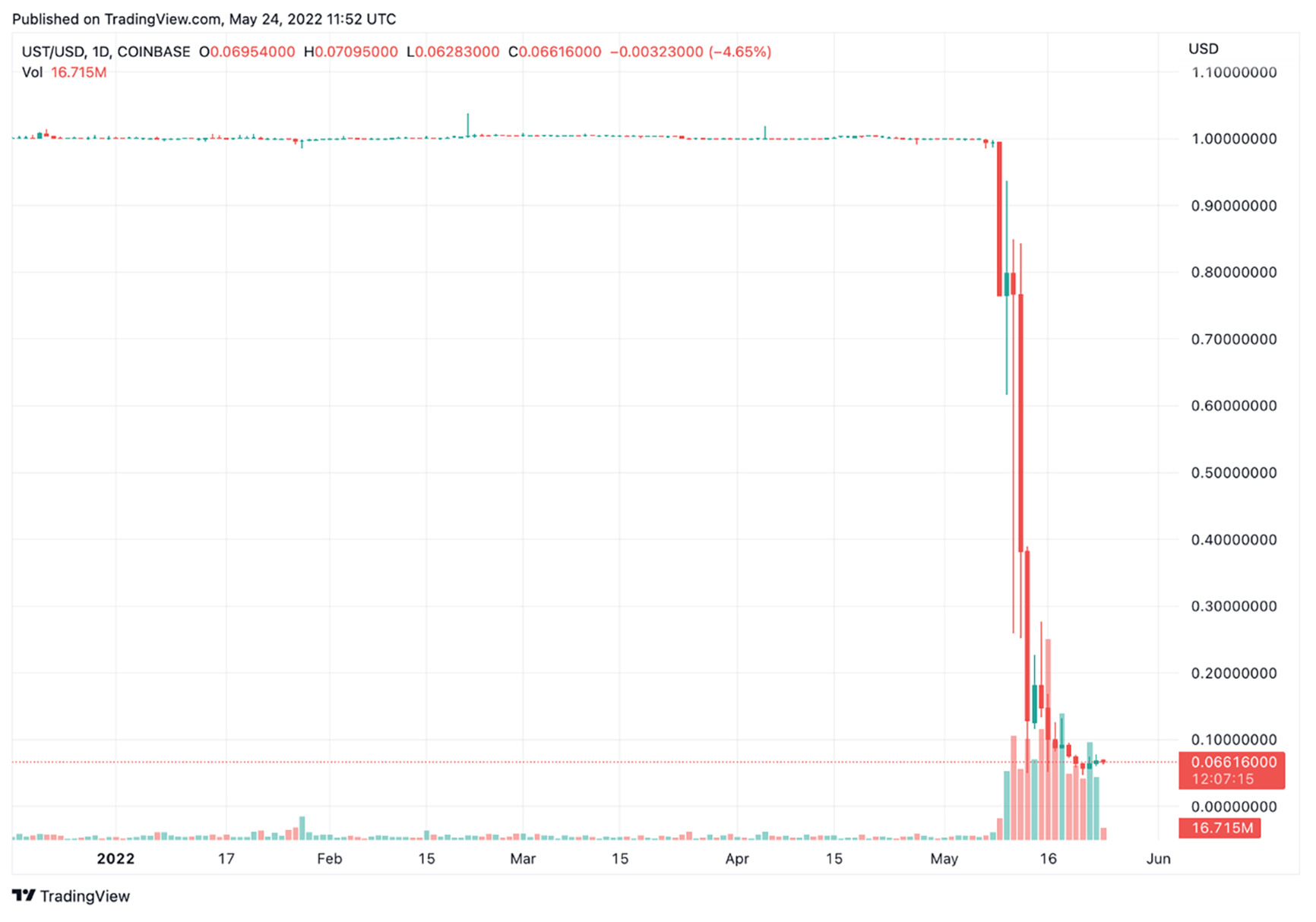Gone to zero: The rise and fall of UST and why we need regulation in the crypto space
At a glance
- Stablecoins are a type of cryptocurrency that are more stable than other cryptocurrencies, as they are typically pegged to a fiat currency, such as the US dollar.
- The UST stablecoin, which was linked to the LUNA token, experienced a crash in May 2022, losing its peg to the dollar and causing significant losses for investors and companies in the crypto space.
The UST crash highlights the need for regulation in the crypto market, particularly in the case of stablecoins, to provide stability, protect investors, and prevent price fluctuations and panic selling. - Regulation could include requirements for cash reserves, risk mitigation strategies, and measures to prevent large-scale asset withdrawals. The US is exploring regulatory guidelines, and South Africa should also consider developing its own regulatory framework.
It has become clear that blockchain technology and the cryptocurrencies it supports are here to stay. It is time to seriously start considering if and how these crypto markets should be regulated. Although the novelty and legal uncertainty surrounding the crypto markets can seem daunting, it is also an extremely exciting field to get involved in and allows for interesting debates around what our executive and legislative branches ought to do. This is especially so in light of the recent crash of the once promising UST stable coin, which had serious and devastating effects on a large number of investors and companies in the crypto space.
What are stablecoins?
For once, the name says it all – stablecoins are a type of crypto currency that are more stable than other cryptocurrencies, which are notorious for their volatility. In the same way that fiat currencies like the dollar used to be backed by gold, the idea behind stablecoins is that they are pegged to types of assets, such as other currencies or valuable metals. At the moment, most stable coins are pegged to a fiat currency, most commonly the US dollar, which means that they are not subject to the steep rising and falling of other cryptocurrencies such as Bitcoin. In a nutshell, it is the type of cryptocurrency you could tell your parents to invest in, without fear that they would wake up to a 30% decrease (or increase) in the value of their investment overnight.
Stablecoins are particularly useful in instances where it is difficult and expensive to transact in standard fiat currencies, potentially as a result of exchange rates or high fees related to transferring money abroad. Additionally, where there are certain fees attached to purchasing cryptocurrencies (mainly as a result of the price fluctuations), these fees are a lot smaller, or in some cases non-existent, when purchasing stablecoins. The stablecoin market has been extremely fast growing over the past year, as many view stablecoins as a safer, more reliable entry into the crypto market.
Before the events of May this year, UST was the largest decentralised stablecoin, with a market capitalisation of almost $200 million in 2021. However, unlike other stablecoins which were directly pegged to the dollar (i.e. there were actual dollar reserves in place backing the price of the coin), UST was linked to a token called LUNA, through an innovative algorithm that used the relationship between UST and LUNA to keep UST pegged to the US dollar (i.e. UST was supposed to retain a value of 1 dollar for every 1 UST).
What happened to UST?
On 8 May 2022, this carefully curated system came crashing down, when UST lost its peg to the dollar and people started panicking. By 13 May, the price of LUNA had gone done by 99,9%. Where it had once exchanged hands at a value of $199, it is now trading at around $0.000112. This in turn had dire consequences for the price of UST, which dropped to lows of $0.023485 – disastrous for a coin that was supposed to never drop below $1.
The chart below shows the characteristic stability of UST, prior to the sudden crash in May this year.

This crash has reportedly wiped out over $15 billion in crypto assets and many individual investors and crypto based companies have been severely affected. This means real life consequences, with many people losing their jobs, large portions of their investments and potentially their life savings.
The question is then, could this have been prevented if there had been more regulation and legal oversight in the market?
The case for regulation
Calls for more regulation in the crypto markets are likely to increase following the UST crash, especially given the sentiment that stablecoins in particular should be the first candidate for regulation. This is particularly so because the types of people and companies who look to invest in and build on stablecoin markets are specifically looking for the type of stability that regulation could bring, unlike with other cryptocurrencies where investors might prefer to speculate and play the market for short-term gains. Apart from the potential support for regulation from stablecoin investors, another important aspect that makes it a good candidate for regulation is the fact that it is supposed to be backed by reserves, to prevent the types of price fluctuations other cryptocurrencies experience. This provides a more tangible point of departure for regulation, that is, creating a regulatory framework around these reserves.
One form of regulation could thus be for the legislature to require that the issuers of stablecoins have a certain amount of cash reserves to prevent against potential “stablecoin runs”. Additionally, certain regulations should be in place to require stablecoin issues to have a publicly available risk mitigation strategy in place that meets certain predetermined criteria. This could assist investors in assessing the level of risk they are taking on when purchasing the stablecoins, but would also protect investors with only a low-level understanding of the mitigation strategy from investing.
A further, and perhaps more unpopular regulatory requirement, would be to have a type of stop mechanism in place to prevent investors from withdrawing large amounts of their assets all at once and thereby causing large price fluctuations and panic selling. This could potentially involve setting up a regulatory body similar to the South African Takeover Regulation Panel which would then regulate trades involving more than a certain percentage of the market capital of a specific coin. A more regulated market invariably means a more stable market, which benefits long-term investors and tech companies looking to build their products around some type of stablecoin.
The US could potentially lead the way in setting regulatory guidelines for the crypto markets, with US President Joe Biden signing an executive order in March this year directing government agencies to co-operate on a regulatory framework. The order specifically seeks to
“support technological advances and ensure responsible development and use of digital assets” and to “explore a US central bank digital currency”.
While it would be interesting to see how the US goes about developing and implementing regulatory measures, South Africa should also be taking steps to develop its own regulatory framework. According to data published by Luno in September 2019, around 15% of South Africans own some form of cryptocurrency, and this number is likely to rise.
The information and material published on this website is provided for general purposes only and does not constitute legal advice. We make every effort to ensure that the content is updated regularly and to offer the most current and accurate information. Please consult one of our lawyers on any specific legal problem or matter. We accept no responsibility for any loss or damage, whether direct or consequential, which may arise from reliance on the information contained in these pages. Please refer to our full terms and conditions. Copyright © 2026 Cliffe Dekker Hofmeyr. All rights reserved. For permission to reproduce an article or publication, please contact us cliffedekkerhofmeyr@cdhlegal.com.
Subscribe
We support our clients’ strategic and operational needs by offering innovative, integrated and high quality thought leadership. To stay up to date on the latest legal developments that may potentially impact your business, subscribe to our alerts, seminar and webinar invitations.
Subscribe



